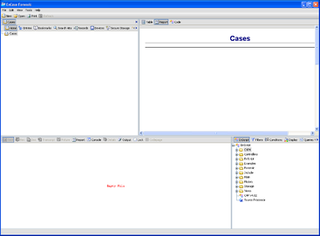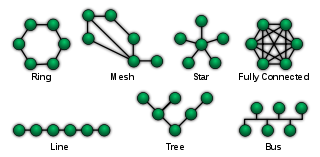
Computer forensics is a branch of digital forensic science pertaining to evidence found in computers and digital storage media. The goal of computer forensics is to examine digital media in a forensically sound manner with the aim of identifying, preserving, recovering, analyzing and presenting facts and opinions about the digital information.
Disk cloning is the process of duplicating all data on a digital storage drive, such as a hard disk or solid state drive, using hardware or software techniques. Unlike file copying, disk cloning also duplicates the filesystems, partitions, drive meta data and slack space on the drive. Common reasons for cloning a drive include; data backup and recovery; duplicating a computer's configuration for mass deployment and for preserving data for digital forensics purposes. Drive cloning can be used in conjunction with drive imaging where the cloned data is saved to one or more files on another drive rather than copied directly to another drive.
In computing, data recovery is a process of retrieving deleted, inaccessible, lost, corrupted, damaged, or formatted data from secondary storage, removable media or files, when the data stored in them cannot be accessed in a usual way. The data is most often salvaged from storage media such as internal or external hard disk drives (HDDs), solid-state drives (SSDs), USB flash drives, magnetic tapes, CDs, DVDs, RAID subsystems, and other electronic devices. Recovery may be required due to physical damage to the storage devices or logical damage to the file system that prevents it from being mounted by the host operating system (OS).
In evidence law, digital evidence or electronic evidence is any probative information stored or transmitted in digital form that a party to a court case may use at trial. Before accepting digital evidence a court will determine if the evidence is relevant, whether it is authentic, if it is hearsay and whether a copy is acceptable or the original is required.

Digital forensics is a branch of forensic science encompassing the recovery, investigation, examination, and analysis of material found in digital devices, often in relation to mobile devices and computer crime. The term "digital forensics" was originally used as a synonym for computer forensics but has expanded to cover investigation of all devices capable of storing digital data. With roots in the personal computing revolution of the late 1970s and early 1980s, the discipline evolved in a haphazard manner during the 1990s, and it was not until the early 21st century that national policies emerged.
Electronic discovery refers to discovery in legal proceedings such as litigation, government investigations, or Freedom of Information Act requests, where the information sought is in electronic format. Electronic discovery is subject to rules of civil procedure and agreed-upon processes, often involving review for privilege and relevance before data are turned over to the requesting party.

The Sleuth Kit (TSK) is a library and collection of Unix- and Windows-based utilities for extracting data from disk drives and other storage so as to facilitate the forensic analysis of computer systems. It forms the foundation for Autopsy, a better known tool that is essentially a graphical user interface to the command line utilities bundled with The Sleuth Kit.
Anti–computer forensics or counter-forensics are techniques used to obstruct forensic analysis.
Device configuration overlay (DCO) is a hidden area on many of today's hard disk drives (HDDs). Usually when information is stored in either the DCO or host protected area (HPA), it is not accessible by the BIOS, OS, or the user. However, certain tools can be used to modify the HPA or DCO. The system uses the IDENTIFY_DEVICE command to determine the supported features of a given hard drive, but the DCO can report to this command that supported features are nonexistent or that the drive is smaller than it actually is. To determine the actual size and features of a disk, the DEVICE_CONFIGURATION_IDENTIFY command is used, and the output of this command can be compared to the output of IDENTIFY_DEVICE to see if a DCO is present on a given hard drive. Most major tools will remove the DCO in order to fully image a hard drive, using the DEVICE_CONFIGURATION_RESET command. This permanently alters the disk, unlike with the host protected area (HPA), which can be temporarily removed for a power cycle.

EnCase is the shared technology within a suite of digital investigations products by Guidance Software. The software comes in several products designed for forensic, cyber security, security analytics, and e-discovery use. EnCase is traditionally used in forensics to recover evidence from seized hard drives. It allows the investigator to conduct in-depth analysis of user files to collect evidence such as documents, pictures, internet history and Windows Registry information.

A forensic disk controller or hardware write-block device is a specialized type of computer hard disk controller made for the purpose of gaining read-only access to computer hard drives without the risk of damaging the drive's contents. The device is named forensic because its most common application is for use in investigations where a computer hard drive may contain evidence. Such a controller historically has been made in the form of a dongle that fits between a computer and an IDE or SCSI hard drive, but with the advent of USB and SATA, forensic disk controllers supporting these newer technologies have become widespread. Steve Bress and Mark Menz invented hard drive write blocking.
Forensic Toolkit, or FTK, is a computer forensics software originally developed by AccessData, an Exterro company. It scans a hard drive looking for various information. It can, for example, potentially locate deleted emails and scan a disk for text strings to use them as a password dictionary to crack encryption.

Forensic profiling is the study of trace evidence in order to develop information which can be used by police authorities. This information can be used to identify suspects and convict them in a court of law.

Network forensics is a sub-branch of digital forensics relating to the monitoring and analysis of computer network traffic for the purposes of information gathering, legal evidence, or intrusion detection. Unlike other areas of digital forensics, network investigations deal with volatile and dynamic information. Network traffic is transmitted and then lost, so network forensics is often a pro-active investigation.
File carving is the process of reassembling computer files from fragments in the absence of filesystem metadata.

Mobile device forensics is a branch of digital forensics relating to recovery of digital evidence or data from a mobile device under forensically sound conditions. The phrase mobile device usually refers to mobile phones; however, it can also relate to any digital device that has both internal memory and communication ability, including PDA devices, GPS devices and tablet computers.

Audio forensics is the field of forensic science relating to the acquisition, analysis, and evaluation of sound recordings that may ultimately be presented as admissible evidence in a court of law or some other official venue.
Gates Rubber Company v. Bando Chemical Industries, Ltd., et al. is a decision by the U.S. district court for the District of Colorado from May 1, 1996. It is considered a landmark decision in terms of expert witness court testimony in questions of electronic evidence and digital forensics.
Fileless malware is a variant of computer related malicious software that exists exclusively as a computer memory-based artifact i.e. in RAM. It does not write any part of its activity to the computer's hard drive, thus increasing its ability to evade antivirus software that incorporate file-based whitelisting, signature detection, hardware verification, pattern-analysis, time-stamping, etc., and leaving very little evidence that could be used by digital forensic investigators to identify illegitimate activity. Malware of this type is designed to work in memory, so its existence on the system lasts only until the system is rebooted.









